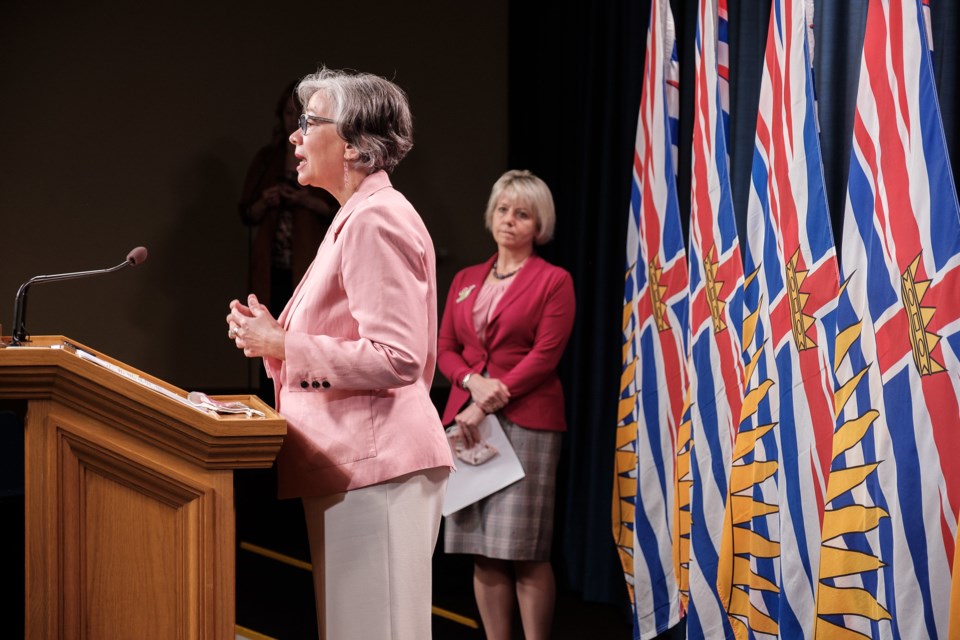B.C.’s education minister Jennifer Whiteside has announced the province’s back-to-school plan for the upcoming school year.
Mandatory mask use for all staff as well as for students in Grades 4 to 12 is among the top priorities for the school year, Whiteside said during a press conference last Tuesday, Aug. 24.
Masks are not mandatory for kindergarten to Grade 3 students, but they are strongly recommended, which is something BC Teachers’ Federation (BCTF) president Teri Mooring said she finds confusing.
“We don’t think the mask mandate went far enough. And while there is a mask mandate for [Grade 4] to 12, the K-3 students aren’t eligible for vaccinations and so it’s surprising and I think won’t make sense to a lot of people as well,” said Mooring.
“The mask policy is directly from what was in place last spring, but I think the problem with that is we are in a different environment with the Delta variant, and we haven’t been in schools when it’s been so prevalent, so we are really going into unknown territory where a lot of the adults will be protected but a lot of the students won’t.
“It’s unfortunate that it wasn’t more clear and decisive around those safety measures.”
Mooring believes the province would have been better suited going with much stronger measures to start the school year, and peeling them back where necessary based on how the pandemic progresses.
In Tuesday’s press conference, Whiteside also announced that the government and all 1,500 schools in the province have been working to ensure ventilation systems in the schools are up to standard, with $87.5 million being invested into air quality improvement in the last year.
“We know that ventilation in schools is very important for the health of students and staff,” said Whiteside. “Forty-four of B.C.’s 60 school districts have upgraded their HVAC systems.”
While ventilation was one of the BCTF’s five requests for safety measures to be implemented this year, Mooring “was hoping for a lot more detail” in terms of the numbers of HEPA filters that have been ordered and some “assurances that work will be finished before school starts.”
Whistler and Squamish schools are among those that have had the ventilation systems revamped, according to a press release from the Sea to Sky School District’s (SD48) superintendent Lisa McCullough.
“Air handling units in all schools have updated MERV-13 filters and will remain as the standard filter in our school district into the future,” read the statement.
“All schools continue with the COVID-19 Ventilation Plan, which includes pre-occupancy and post-occupancy outdoor air flush of all interior spaces. During occupied time, the ventilation air exchange rate is increased with up to 100-per-cent outside air entering the facilities.”
Certain safety measures like increased hand hygiene, the mask mandate and enhanced cleaning and disinfecting will remain the same as last year among the district’s schools.
However, some changes to last year’s safety guidelines include plans to reduce crowding at pick-up points and common areas like hallways; school buses returning to regular seating and onloading/offloading practices; and intramurals, athletics, field trips and school facility rentals resuming as normal.
On top of the mask mandate and ventilation upgrades the government announced, the other three BCTF requests include school-based vaccination clinics for easy access to vaccines for students, a comprehensive COVID-19 testing strategy including asymptomatic testing and designated time for health and safety training at all schools.
“Work is definitely not done. We will continue to advocate. The health and safety guidelines for schools are not set in stone—there are areas we think need to be enhanced and clarified and we will continue to advocate at the steering committee level,” said Mooring.
“There definitely are some positives there, but overall families and teachers are going to come away from that announcement feeling like there just isn’t enough safety measures in place.”
One of those positives, according to Mooring, is the regional-based approach that allows individual schools or entire school districts to set up their own guidelines based on that specific health region’s recommendations.
“Because this virus isn’t the same everywhere, we are seeing some really troubling scenarios play out in the Okanagan and northern B.C.,” said Mooring. “There is also a great deal of vaccine hesitancy in some areas and so a regional approach makes a lot of sense, and then it’s going to be up to the local health authorities to make sure additional health measures are in place if necessary.”
While the SD48 District Parent Advisory Council (DPAC) is in the process of electing a new executive and preparing for its AGM on Sept. 27, departing chair Meredith Gardner said in an email that district staff were very diligent in working to minimize transmission at school last year, while also keeping students in school for their well-being.
That said, “there were some significant challenges that my family experienced with a lack of resources for student support both in school and online,” Gardner said. “I know that many kids, especially those with Individual Education Plans, and their families have struggled deeply through the pandemic.”
DPAC, along with senior staff and the Board of Education, have also worked together to form a new SD48 Inclusion Committee (SDIC), Gardner added.
Students return to class on Tuesday, Sept. 7.



